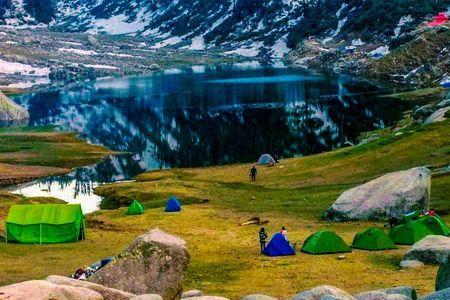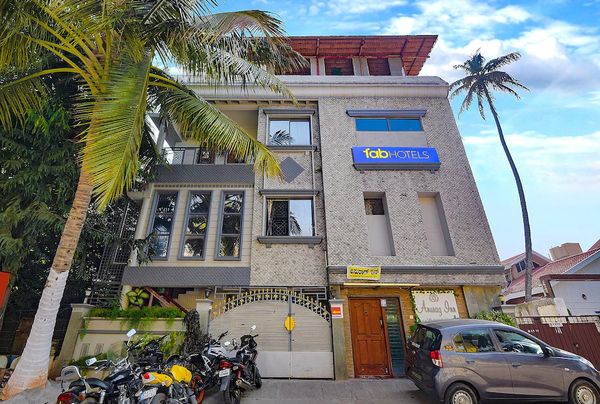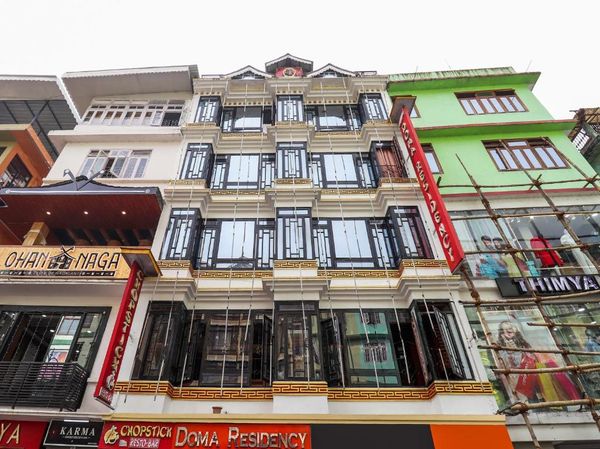Camp by the Clouds: Exploring the Kareri Lake Trek Experience
 Palakshi Meharwal
14 May, 2025
10 mins read
25
Palakshi Meharwal
14 May, 2025
10 mins read
25

Hidden away in the verdant embrace of the Dhauladhar range, the Kareri Lake Trek offers more than just a hiking trail—it offers a chance to camp among clouds, sip on glacial waters, and disconnect from the noise of modern life. Situated at an altitude of approximately 2,934 meters (9,626 feet), Kareri Lake is a pristine high-altitude freshwater lake in Himachal Pradesh, India, nourished by the melting snow of the surrounding peaks. Trekking to this gem is not only a visual treat but also a meditative escape into nature’s raw beauty.
In this article, we’ll explore the complete Kareri Lake trekking experience—from the trail’s terrain and seasonal conditions to cultural highlights and practical planning tips—crafted to engage human readers while upholding the highest standards of content quality.
The Route Less Taken: Trail Overview
The Kareri Lake Trek begins in the small village of Kareri, located about 25 kilometers from Dharamshala. While relatively less commercialized than other Himachali treks like Triund or Hampta Pass, Kareri’s route is no less captivating. The journey takes hikers through dense pine forests, along babbling brooks, and across quaint wooden bridges, offering a constantly evolving landscape.
The trail spans approximately 13–14 kilometers one way and is suitable for beginners with a reasonable level of fitness. It typically takes 2 to 3 days to complete, depending on the itinerary and acclimatization needs.
Highlights of the Trek
Forests and Flora
Early segments of the trek wind through chir and pine forests. Ferns carpet the ground while wildflowers pepper the path, especially during the post-monsoon season. The lower elevation provides cool shade and a soundtrack of bird calls, setting a peaceful tone.
Alpine Meadows
As one ascends, the forest gives way to open meadows. These high-altitude pastures, locally called ‘Bugyals,’ are grazing grounds for sheep and cattle. Trekkers often encounter Gaddi shepherds, who are semi-nomadic and known for their resilience and traditional mountain lifestyle.
Nyund Nallah
One of the trek’s constants is the gurgling Nyund Nallah, a stream sourced directly from the lake. Its icy waters run parallel to the trail, offering both orientation and refreshment. Several makeshift log bridges span the stream, adding a rustic thrill to the journey.
Kareri Lake
Upon reaching the lake, the view is nothing short of magical. Cradled by mountains and ringed with boulders and alpine grass, the glacial lake mirrors the sky, clouds, and peaks above. The nearby Kareri Temple, dedicated to Lord Shiva, adds a spiritual dimension to the location. Campers often pitch tents along the lake's banks, experiencing a night under the stars with the occasional snow flurry, depending on the season.
Best Time to Visit
Kareri Lake is best visited between May and early July, and then again from mid-September to November. During the summer, the trail is lined with blooming flora, and the lake is easily accessible. Autumn offers crisp weather and golden hues in the surrounding landscape.
The monsoon months (July to August) are generally avoided due to slippery trails and landslide risks, while winter (December to March) transforms the lake into a frozen expanse, only suitable for experienced trekkers with proper gear.
Planning and Preparation
Gear Checklist
- Footwear: Waterproof trekking shoes with good ankle support are essential.
- Clothing: Layered outfits are key—light base layers, insulating mid-layers, and waterproof outer shells.
- Sleeping Bag: Temperatures can drop significantly at night, so a sleeping bag rated for sub-zero conditions is advisable.
- Essentials: Trekking poles, headlamp, sunscreen, water purifier or tablets, and a basic first-aid kit.
Permits and Guides
While no special permits are required for Indian citizens to trek to Kareri Lake, hiring a local guide is highly recommended. Guides not only ensure safety but also enrich the journey with stories, cultural context, and knowledge of the local terrain. Many reputable trekking agencies based in Dharamshala offer packages that include transportation, meals, tents, and guides.
Eco-conscious Trekking
Given the fragile ecosystem of high-altitude lakes, responsible trekking practices are paramount. Trekkers should follow a strict “Leave No Trace†policy—carry back all waste, avoid plastic use, and minimize impact on local flora and fauna. Campfires are discouraged due to deforestation risks; opt for portable stoves instead.
Cultural Connections
Kareri village and the neighboring hamlets are inhabited by Gaddi tribes, known for their rich oral traditions, unique attire, and centuries-old herding culture. Engaging with locals not only supports the community economically but also deepens the travel experience. Some homestays in Kareri offer home-cooked meals and a glimpse into traditional Himachali hospitality.
Physical and Mental Rewards
While the physical exertion of trekking is evident, the mental clarity gained along the trail is perhaps its most cherished reward. The absence of mobile connectivity encourages digital detox, while the stillness of the lake and vast skies foster introspection and peace.
Travel Tips
- Getting There: The nearest major town is Dharamshala, well-connected by road to Delhi and Chandigarh. Gaggal Airport (DHM), approximately 13 kilometers from Dharamshala, offers limited flights. From Dharamshala, private cabs or local buses can take you to Kareri village.
- Health Precautions: Acclimatization is less of an issue at Kareri’s altitude, but staying hydrated and avoiding sudden elevation gain are still essential. If trekking in early spring or late autumn, check for snow or icy trail conditions.
- Budgeting: On average, an independent trek can cost between ₹2,500 to ₹5,000 (INR) per person for a 2–3 day itinerary, depending on whether you hire guides, rent gear, or book a package tour.
Why Kareri Stands Out
What sets the Kareri Lake Trek apart is its versatility—it’s approachable enough for first-time trekkers but rewarding enough to leave even seasoned hikers awed. Its compact itinerary makes it ideal for long weekends, yet its emotional and sensory payoff feels disproportionately large. Unlike more crowded trails, Kareri retains a sense of untouched charm.
Final Thoughts
Kareri Lake is more than a destination—it’s a dialogue between mountains and sky, between solitude and community, and between the self and the natural world. Camping by its banks is not just an overnight stay but a full immersion into Himalayan wonder. For those yearning for a trek that balances accessibility with alpine grandeur, Kareri offers an unforgettable, cloud-kissed retreat.
By choosing to explore Kareri Lake with mindfulness and preparation, you not only enrich your personal experience but also help preserve a fragile ecosystem for future adventurers.
Written By:
Palakshi Meharwal



Hotels at your convenience
Now choose your stay according to your preference. From finding a place for your dream destination or a mere weekend getaway to business accommodations or brief stay, we have got you covered. Explore hotels as per your mood.





